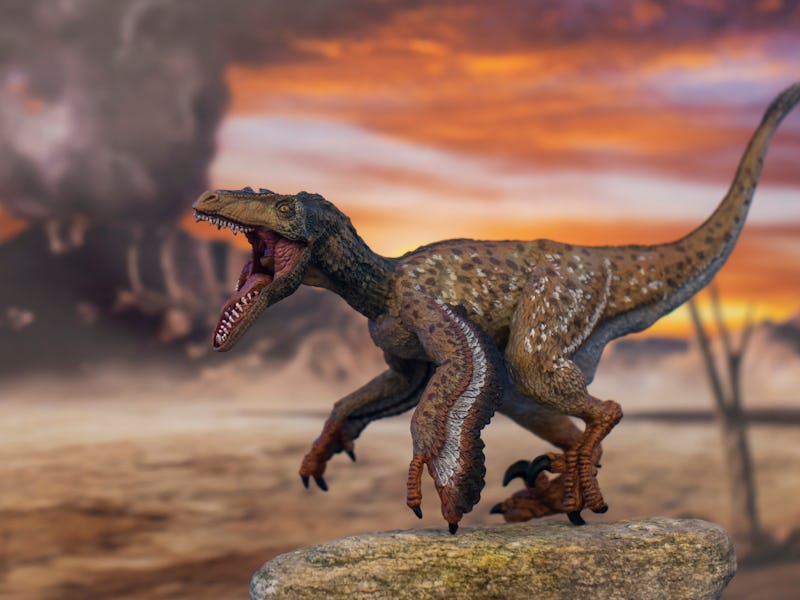Protofeathers may have helped dinosaurs survive — and dominate
Plus: 25 years of NASA’s Mars rovers.

Until about 202 million years ago, dinosaurs were relatively minor players on the global stage. Instead, Earth's tropical and subtropical regions were dominated by other reptiles.
Then came the end of the Triassic and the start of the Jurassic, which saw a mass extinction, killing off more than three-quarters of all species on the planet, including all sizable reptiles. This cataclysm also saw the dinosaurs emerge as major players. Why they thrived when their competitors died has long been a mystery. Now, scientists have new clues.
This is an adapted version of the Inverse Daily newsletter for Thursday, July 7, 2022. Subscribe for free and learn something new every day.
NASA's Mars Pathfinder Lander and the Sojourner Rover on Mars.
25 years ago, NASA landed its first Rover on Mars — and catalyzed the search for life
In July, 1997, NASA landed its first rover on Mars, called Pathfinder, and beamed back a photo from the planet’s surface. In doing so, the space agency set up its first science lab on another world.
Creating Pathfinder took three years and $265 million dollars. At the time, scientists had no idea whether the rover would survive the 34 million-mile journey to reach Mars. As Pathfinder started to approach the Red Planet, it careened right at its surface with no brakes, slicing through the thin Martian atmosphere at seven kilometers per second.
But the rover touched down safely, leaving scientists overjoyed. Across its 10-month mission, Pathfinder broke new ground in planetary science, offering humans a glimpse of Mars in much the same way we view our home on Earth — from the surface.
“It was the beginning of a Mars Renaissance,” says Matthew Golombek, the mission’s project scientist. “Pathfinder was without question the most robust lander we ever sent to Mars.”
A fossil of Archaeopteryx, a genus of bird-like dinosaurs.
Bird-like feathers may have helped dinosaurs survive an icy world
Dinosaurs are often depicted as dwelling in tropical climes. Now, a team of researchers suggests that a number of the ancient reptiles may have endured freezing winters in the Arctic, potentially with the help of feather-like coverings.
In the new study, published in the journal Science Advances, scientists examined recent excavations in the remote desert of northwest China's Junggar Basin. Back then, the area lay at roughly 71 degrees north, well above the Arctic Circle. More importantly, dinosaur footprints were found.
"Evidence of polar dinosaurs has been accumulating for over a century,” says study lead author Paul Olsen. “That itself is not new. However, evidence that they were living in areas with freezing winters has been scant to non-existent."
How could dinosaurs survive such cold climates? One has only to look at the world's only surviving dinosaurs, birds.
About 60% of the human body is water.
Do you need to drink 8 glasses of water per day? Scientists demystify the number
You’ve probably been advised to drink 8 glasses of water per day. It sounds like practical health advice, but is it true?
“Hydration is the most essential nutrient needed to sustain life,” says kinesthesiologist William Adams of University of North Carolina at Greensboro. Between 50 and 70 percent of our bodies are made up of water; it’s essential for many cellular, metabolic, and thermoregulatory functions within our bodies.
How much each person should drink, though, depends. The U.S. National Academies of Science, Engineering, and Medicine recommends that women consume 9 to 12 eight-ounce glasses, while men intake 11 to 16, daily.
Other factors that may require more hydration include: sweat levels, exercise, and high-altitudes. So, if you’re hiking through the mountains this summer, make sure to watch out for signs of dehydration; for example, if your urine starts to look like apple juice instead of lemonade.
Do you see the manatee?
Astrophysicists finally decipher weird beams emanating from Manatee Nebula
The Manatee Nebula is what’s left of a massive star that exploded about 30,000 years ago. If we could see it with our unaided eyes, it would take up a swath of sky four times wider than the full Moon.
Most of the time, the demise of a massive star leaves behind the star’s core in the form of a super-dense ball of neutrons called a neutron star. In the heart of the Manatee Nebula, however, what’s left is a black hole, blasting X-rays and charged particles into space at a quarter of the speed of light. Why that is has eluded experts, until very recently.
In 2018, a team of astronomers noticed that something in the Manatee Nebula was sending very high-energy particles zipping toward Earth, but they couldn’t identify the source. Now, it turns out that, if you can see the manatee shape that gives the nebula its name, the high-energy particles are coming from the manatee’s head.
Scientists call these charged particles relativistic jets. The ones from the Manatee Nebula’s black hole move much faster than the expanding gas cloud, quickly catching up with the leading edge of the gas, and then punching a hole through it on their way out into space.
Supernova remnants, explained.
Ladies and gentlemen, the Opportunity rover.
About this newsletter: Do you think it can be improved? Have a story idea? Want to share a story about the time you met an astronaut? Send those thoughts and more to newsletter@inverse.com.
- On this day in history: On July 7, 2003, NASA launched its Mars rover, Opportunity, which remained operational for 5,250 days.
- Song of the day: “Cute” by Moonchild Sanelly
Subscribe for free and learn something new every day!